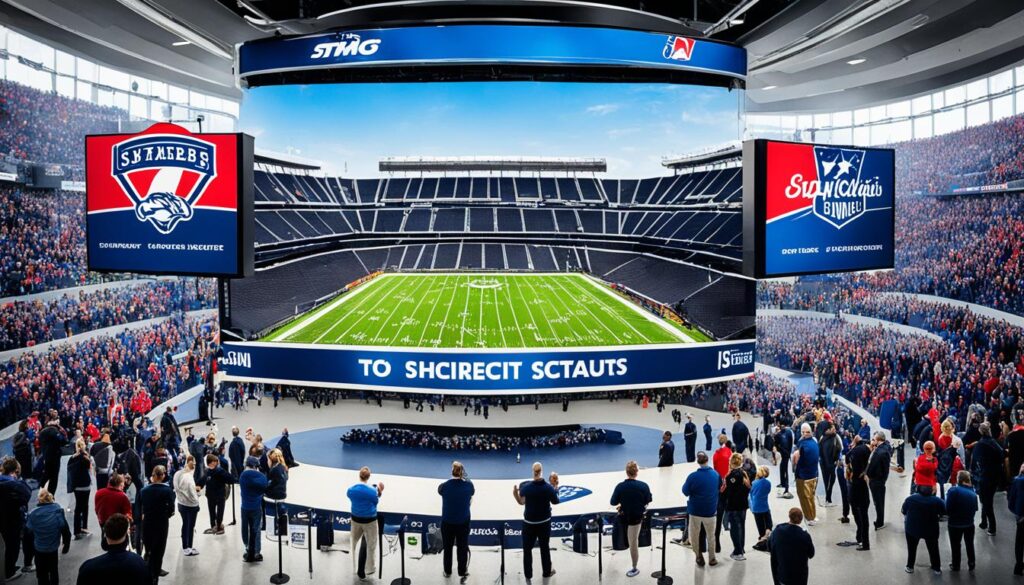

Sports Club Business Plan: How To Do It [Guide]
Are you an enthusiast looking to start a sports club? Perhaps you dream of building a thriving sports community that brings people together and promotes physical activity.
As an industry professional in the context of sports clubs, I understand the importance of a well-crafted business plan.
In this comprehensive guide, I will share knowledge and insights to help you develop a winning sports club business plan that sets you up for success.
Table of Content
- Introduction
- Defining Your Vision and Mission
- Market Research and Analysis
- Building Your Sports Club Structure
- Financial Planning and Budgeting
- Marketing and Promotion
- Operations and Management
- Facilities and Equipment
- Risk Management and Legal Considerations
- Measuring Success and Growth
1. Introduction
Starting a sports club can be an exciting venture, but it requires careful planning to turn your vision into a reality.
A well-structured business plan is the foundation of every successful sports club. It not only outlines your objectives but also serves as a roadmap for achieving them.
Let’s dive into the essential steps of creating a sports club business plan.
2. Defining Your Vision and Mission
Before you start writing your business plan, it’s crucial to clearly define your sports club’s vision and mission. Ask yourself the following questions:
- What is the purpose of your sports club?
- What values and principles do you want to promote through your club?
- What are your long-term and short-term goals?
By identifying your club’s purpose and setting specific goals, you’ll be better equipped to create a focused and impactful business plan.
Setting Clear Goals and Objectives
To ensure your business plan is actionable, set clear and measurable objectives. Consider the following factors:
- The number of members you aim to attract in the first year
- The frequency of sports events or activities you plan to organize
- Financial targets, such as revenue and expenses
3. Market Research and Analysis
Understanding the sports industry landscape is essential for a successful sports club. Conduct thorough market research to gain insights into your potential target audience and competitors.
Analyzing the Sports Industry Landscape
Research trends and market demands in the sports industry. Determine which sports are popular in your region and how you can capitalize on those interests.
Identifying Your Target Audience and Competition
Define your target audience based on demographics, interests, and preferences. Identify your competitors and analyze their strengths and weaknesses to find opportunities for differentiation.
4. Building Your Sports Club Structure
The foundation of a successful sports club lies in its structure and offerings.
Choosing the Right Sports and Activities
Select sports and activities that align with your club’s vision and cater to your target audience’s interests. Consider offering a diverse range of options to attract a broader audience.
Selecting the Ideal Location
The location of your sports club can significantly impact its success. Choose a place easily accessible to your target audience and with sufficient space to accommodate your activities.
5. Financial Planning and Budgeting
Developing a sound financial plan is crucial for the sustainable growth of your sports club.
Estimating Initial Costs and Investments
Calculate the initial costs of setting up the club, including facility rent, equipment purchase, and staff recruitment.
Developing a Sustainable Financial Model
Create a detailed financial forecast to estimate revenues and expenses over time. This will help you ensure the financial viability of your sports club.
6. Marketing and Promotion
Effectively marketing your sports club will attract potential members and increase your visibility.
Creating a Brand Identity for Your Sports Club
Develop a strong brand identity that resonates with your target audience. This includes creating a compelling logo, tagline, and mission statement.
Leveraging Digital Marketing Channels
Utilize online platforms and social media to reach a wider audience. Engage with potential members through content marketing and community building.
7. Operations and Management
Efficient day-to-day operations are vital for delivering a seamless experience to your club members.
Establishing Efficient Day-to-day Operations
Develop standard operating procedures (SOPs) to streamline administrative tasks and ensure smooth club operations.
Building a Strong Team and Leadership
Recruit passionate and knowledgeable individuals to manage and lead your sports club. Effective leadership will drive growth and foster a positive club culture.
8. Facilities and Equipment
Investing in quality facilities and equipment is essential for providing a top-notch experience to your members.
Ensuring Adequate Facilities and Amenities
Ensure that your club’s facilities meet the needs of your chosen sports and activities. Offer amenities that enhance the overall experience for members.
Selecting Quality Sports Equipment
Invest in high-quality sports equipment that is safe and durable. Well-maintained equipment will contribute to a positive member experience.
9. Risk Management and Legal Considerations
Mitigating risks and complying with legal requirements protect both your club and its members.
Mitigating Risks and Liabilities
Implement safety protocols and insurance coverage to protect your members from potential accidents or injuries.
Complying with Legal Requirements
Ensure that your sports club adheres to all relevant legal and regulatory guidelines, including permits and licenses.
10. Measuring Success and Growth
Regularly evaluating your club’s performance and progress will help you make informed decisions and identify areas for improvement.
Setting Key Performance Indicators (KPIs)
Establish measurable KPIs to monitor the success of your sports club. These may include member retention rates, revenue growth, and event attendance.
Evaluating and Adapting Your Business Plan
Periodically review and update your business plan based on data-driven insights. This will enable you to adapt to changing market conditions and member preferences.
11. Conclusion
Congratulations! You now have a comprehensive understanding of how to create a successful sports club business plan. By defining your vision, conducting thorough research, and implementing effective marketing and management strategies, you are well-equipped to build a thriving sports community.
Remember that the journey of starting and managing a sports club may have challenges, but with dedication, passion, and the right business plan, you can turn your dream into a reality.
Good luck on your sports club venture! Here’s to a bright and prosperous future filled with sportsmanship, camaraderie, and success!

Hello! I’m Magnus Berglund , a seasoned trendspotter and proud founder of SportsBizTrends.com .
With over a decade of experience as an independent advisor and consultant, I have specialized in business development and creative marketing within the sports industry . This has, among other things, resulted in a book about sports sponsorship (only available in Swedish for the moment).
If you find my writing interesting, please share it with your colleagues and friends. It would be greatly appreciated!
And yes, I do freelance consulting and provide lectures at industry events, business networks, board meetings, and similar occasions. However, since I also work as a Marketing Manager for an industrial company, I choose the occasions wisely.
That said, don’t hesitate to contact me with your inquiry .
With experience from various assignments in strategy, tactical activations, and valuation of sponsorship (from the grassroots level to the English Premier League), I am happy to share my insights and ideas in this fast-paced industry.
For more information about me and my work, including my contact details, please visit the About page , or connect with me via LinkedIn .
These articles may interest you:

Data-Driven Success: Leveraging Analytics Tools in Sports Marketing
In today’s digital age, making data-driven decisions is crucial for success in the world of sports marketing. With the abundance of analytics tools and data…

Why Gross Impressions Are Important for the Success of Sports Marketing
Gross impressions play a crucial role in sports marketing, helping brands reach and engage with their target audience. In this article, we will explore the fundamental concepts…

What Are Sports Agents: Unveiling the Role of Agents in the Sports Industry
Welcome to an insightful journey into the world of sports agents! In this comprehensive article, we will explore the crucial role played by sports agents…

Marketing for Physical Therapists – 20 Tips for New Customers & More Sales
Welcome, fellow physical therapists! Marketing might sound daunting but fear not. I’m here to share 10 creative marketing ideas for physical therapists that won’t break…

How to Improve the Fan Experience at Live Sports Events [10 Steps]
In today’s digital age, sports fans have many options when it comes to watching their favorite teams play. However, there is still something special about…

Marketing for Sports Travel Agency – 10 Unique Tips for New Customers & More Sales
Welcome to the world of marketing for your Sports Travel Agency! As a small business owner in the sports travel industry, you may not have…

Marketing for Bike Shops – 20 Tips for New Customers & More Sales
Welcome to a world of marketing tailored for bike shop owners! In this article, you’ll discover creative and budget-friendly marketing ideas that will help you…

The Crucible Chronicles: Unveiling the Storied Legacy of the World Snooker Championship
Basking in the heart of Sheffield, England, the Crucible Theatre stands as a timeless venue, weaving together the elegance of traditional theater and the gripping…

Strategic Impact: Thoughtful Ad Placement in Sports Marketing
Sports marketing campaigns have the power to captivate sports fans and create a deep connection with brands. Whether it’s through sponsorships or digital promotions, strategic…
- Sample Business Plans
- Entertainment & Media
Sports Complex Business Plan

Fitness courses, sports leagues, and camps are just a few of the activities that a sports complex can provide to boost profitability. Though the business of sports is really expensive, it is rewarding as well, but without accurate planning your business might fail.
Need help writing a business plan for your sports complex business? You’re at the right place. Our sports complex business plan template will help you get started.

Free Business Plan Template
Download our Free Sports Complex Business Plan Template now and pave the way to success. Let’s turn your vision into an actionable strategy!
- Fill in the blanks – Outline
- Financial Tables
How to Write a Sports Complex Business Plan?
Writing a sports complex business plan is a crucial step toward the success of your business. Here are the key steps to consider when writing a business plan:
1. Executive Summary
An executive summary is the first section planned to offer an overview of the entire business plan. However, it is written after the entire business plan is ready and summarizes each section of your plan.
Here are a few key components to include in your executive summary:
- Introduce your business: Start your executive summary section by briefly introducing your business to your readers.
- This section may include the name of your sports complex business, its location, when it was founded, etc.
- Market opportunity: Summarize your market research, including market size, growth potential, and marketing trends. Highlight the opportunities in the market and how your business will fit in to fill the gap.
- Product & services: Highlight the products or services you offer your clients. The USPs and differentiators you offer are always a plus.
- You may include services like swimming, personal training for sports, basketball court, fitness classes, spa services, sports equipment, etc.
- Marketing & sales strategies: Outline your sales and marketing strategies—what marketing platforms you use, how you plan on acquiring customers, etc.
- Financial highlights: Briefly summarize your financial projections for the initial years of business operations. Include any capital or investment requirements, associated startup costs, projected revenues, and profit forecasts.
- Call to action: Summarize your executive summary section with a clear CTA, for example, inviting angel investors to discuss the potential business investment.
Ensure your executive summary is clear, concise, easy to understand, and jargon-free.
Say goodbye to boring templates
Build your business plan faster and easier with AI
Plans starting from $7/month

2. Business Overview
The business overview section of your business plan offers detailed information about your company. The details you add will depend on how important they are to your business. Yet, business name, location, business history, and future goals are some of the foundational elements you must consider adding to this section:
- Business description: Describe your business in this section by providing all the basic information:
- Multi sports complex
- Indoor sports complex
- Sports training facilities
- Golf courses
- Skate parks
- Indoor trampoline
- Describe the legal structure of your sports complex business, whether it is a sole proprietorship, LLC, partnership, or others.
- Explain where your business is located and why you selected the place.
- Owners: List the names of your sports complex business’s founders or owners. Describe what shares they own and their responsibilities for efficiently managing the business.
- Mission statement: Summarize your business’ objective, core principles, and values in your mission statement. This statement needs to be memorable, clear, and brief.
- Business history: If you’re an established sports complex business, briefly describe your business history, like—when it was founded, how it evolved over time, etc.
- Additionally, If you have received any awards or recognition for excellent work, describe them.
- Future goal: It’s crucial to convey your aspirations and vision. Mention your short-term and long-term goals; they can be specific targets for revenue, market share, or expanding your services.
This section should provide a thorough understanding of your business, its history, and its future plans. Keep this section engaging, precise, and to the point.
3. Market Analysis
The market analysis section of your business plan should offer a thorough understanding of the industry with the target market, competitors, and growth opportunities. You should include the following components in this section.
- Target market: Start this section by describing your target market. Define your ideal customer and explain what types of services they prefer. Creating a buyer persona will help you easily define your target market to your readers.
- For instance, youth, athletes, and fitness enthusiasts can be your target market.
- Market size and growth potential: Describe your market size and growth potential and whether you will target a niche or a much broader market.
- Competitive analysis: Identify and analyze your direct and indirect competitors. Identify their strengths and weaknesses, and describe what differentiates your sports complex business from them. Point out how you have a competitive edge in the market.
- Market trends: Analyse emerging trends in the industry, such as technology disruptions, changes in customer behavior or preferences, etc. Explain how your business will cope with all the trends.
- For instance, diversification in sports services plus the trend for eco-friendly services are also increasing, mention how you will cope with that.
- Regulatory environment: List regulations and licensing requirements that may affect your sports complex business such as zoning regulations, health & safety regulations, environmental regulations, insurance & liability, etc.
Here are a few tips for writing the market analysis section of your sports complex business plan:
- Conduct market research, industry reports, and surveys to gather data.
- Provide specific and detailed information whenever possible.
- Illustrate your points with charts and graphs.
- Write your business plan keeping your target audience in mind.
4. Products And Services
The product and services section should describe the specific services and products that will be offered to customers. To write this section should include the following:
- Tournaments
- Types of sports facilities will be there (basketball court, tennis, badminton, swimming, golf, etc)
- Mention the facilities: Describe the sports complex’s physical amenities, such as the size and design of the building(s), the kinds of courts or fields, and any equipment or customer amenities (such as changing rooms, showers, and snack bars).
- Mention your schedule list: Give a list of future competitions, events, and other unique activities that the sports complex will be hosting. It will show the variety and caliber of the products and services that are offered to customers.
In short, this section of your sports complex plan must be informative, precise, and client-focused. By providing a clear and compelling description of your offerings, you can help potential investors and readers understand the value of your business.

5. Sales And Marketing Strategies
Writing the sales and marketing strategies section means a list of strategies you will use to attract and retain your clients. Here are some key elements to include in your sales & marketing plan:
- Unique selling proposition (USP): Define your business’s USPs depending on the market you serve, the equipment you use, and the unique services you provide. Identifying USPs will help you plan your marketing strategies.
- For example, advanced equipment, more space, or amazing training courses can be your USP.
- Pricing strategy: Describe your pricing strategy—how you plan to price your business and stay competitive in the local market. You can mention any discounts you plan on offering to attract new customers to your sports complex.
- Marketing strategies: Discuss your marketing strategies to market your services. You may include some of these marketing strategies in your business plan—social media marketing, Google ads, brochures, email marketing, content marketing, and print marketing.
- Sales strategies: Outline the strategies you’ll implement to maximize your sales. Your sales strategies may include offering discounts on annual membership, referral programs, etc.
- Customer retention: Describe your customer retention strategies and how you plan to execute them. For instance, introducing loyalty programs, personalized service, etc.
Overall, this section of your sports complex business plan should focus on customer acquisition and retention.
Have a specific, realistic, and data-driven approach while planning sales and marketing strategies for your sports complex business, and be prepared to adapt or make strategic changes in your strategies based on feedback and results.
6. Operations Plan
The operations plan section of your business plan should outline the processes and procedures involved in your business operations, such as staffing requirements and operational processes. Here are a few components to add to your operations plan:
- Staffing & training: Mention your business’s staffing requirements, including the number of employees, coaches, or trainers. Include their qualifications, the training required, and the duties they will perform.
- Operational process: Outline the processes and procedures you will use to run your sports complex business. Your operational processes may include sending quotations, scheduling classes, etc.
- Equipment: Include the list of equipment required for the sports complex, such as fitness equipment, sports equipment, mats & padding, etc.
Adding these components to your operations plan will help you lay out your business operations, which will eventually help you manage your business effectively.
7. Management Team
The management team section provides an overview of your sports complex business’s management team. This section should provide a detailed description of each manager’s experience and qualifications, as well as their responsibilities and roles.
- Founder/CEO: Mention the founders and CEO of your sports complex company, and describe their roles and responsibilities in successfully running the business.
- Key managers: Introduce your management and key members of your team, and explain their roles and responsibilities.
- It should include, key executives, senior management, and other sports managers including their education, professional background, and any relevant experience in the industry.
- Organizational structure: Explain the organizational structure of your management team. Include the reporting line and decision-making hierarchy.
- Compensation plan: Describe your compensation plan for the management and staff. Include their salaries, incentives, and other benefits.
- Advisors/consultants: Mentioning advisors or consultants in your business plans adds credibility to your business idea.
- So, if you have any advisors or consultants, include them with their names and brief information consisting of roles and years of experience.
This section should describe the key personnel for your sports complex business, highlighting how you have the perfect team to succeed.
8. Financial Plan
Your financial plan section should provide a summary of your business’s financial projections for the first few years. Here are some key elements to include in your financial plan:
- Profit & loss statement: Describe details such as projected revenue, operational costs, and service costs in your projected profit and loss statement. Make sure to include your business’s expected net profit or loss.
- Cash flow statement: The cash flow for the first few years of your operation should be estimated and described in this section. This may include billing invoices, payment receipts, loan payments, and any other cash flow statements.
- Balance sheet: Create a projected balance sheet documenting your sports complex business’s assets, liabilities, and equity.
- Break-even point: Determine and mention your business’s break-even point—the point at which your business costs and revenue will be equal.
- This exercise will help you understand how much revenue you need to generate to sustain or be profitable.
- Financing needs: Calculate costs associated with starting a sports complex business, and estimate your financing needs and how much capital you need to raise to operate your business. Be specific about your short-term and long-term financing requirements, such as investment capital or loans.
Be realistic with your financial projections, and make sure you offer relevant information and evidence to support your estimates.
9. Appendix
The appendix section of your plan should include any additional information supporting your business plan’s main content, such as market research, legal documentation, financial statements, and other relevant information.
- Add a table of contents for the appendix section to help readers easily find specific information or sections.
- In addition to your financial statements, provide additional financial documents like tax returns, a list of assets within the business, credit history, and more. These statements must be the latest and offer financial projections for at least the first three or five years of business operations.
- Provide data derived from market research, including stats about the industry, user demographics, and industry trends.
- Include any legal documents such as permits, licenses, and contracts.
- Include any additional documentation related to your business plan, such as product brochures, marketing materials, operational procedures, etc.
Use clear headings and labels for each section of the appendix so that readers can easily find the necessary information.
Remember, the appendix section of your sports complex business plan should only include relevant and important information supporting your plan’s main content.
The Quickest Way to turn a Business Idea into a Business Plan
Fill-in-the-blanks and automatic financials make it easy.
This sample sports complex business plan will provide an idea for writing a successful sports complex plan, including all the essential components of your business.
After this, if you still need clarification about writing an investment-ready business plan to impress your audience, download our sports complex business plan pdf .
Related Posts
400+ Sample Business Plans Template
Make Perfect Business Plan Outline
Business Plan Builders with AI
Essential Elements of a Business Plan
Frequently Asked Questions
Why do you need a sports complex business plan.
A business plan is an essential tool for anyone looking to start or run a successful sports complex business. It helps to get clarity in your business, secures funding, and identifies potential challenges while starting and growing your business.
Overall, a well-written plan can help you make informed decisions, which can contribute to the long-term success of your sports complex company.
How to get funding for your sports complex business?
There are several ways to get funding for your sports complex business, but self-funding is one of the most efficient and speedy funding options. Other options for funding are:
- Bank loan – You may apply for a loan in government or private banks.
- Small Business Administration (SBA) loan – SBA loans and schemes are available at affordable interest rates, so check the eligibility criteria before applying for it.
- Crowdfunding – The process of supporting a project or business by getting a lot of people to invest in your business, usually online.
- Angel investors – Getting funds from angel investors is one of the most sought startup options.
Apart from all these options, there are small business grants available, check for the same in your location and you can apply for it.
Where to find business plan writers for your sports complex business?
There are many business plan writers available, but no one knows your business and ideas better than you, so we recommend you write your sports complex business plan and outline your vision as you have in your mind.
What is the easiest way to write your sports complex business plan?
A lot of research is necessary for writing a business plan, but you can write your plan most efficiently with the help of any sports complex business plan example and edit it as per your need. You can also quickly finish your plan in just a few hours or less with the help of our business plan software.
About the Author
Upmetrics Team
Upmetrics is the #1 business planning software that helps entrepreneurs and business owners create investment-ready business plans using AI. We regularly share business planning insights on our blog. Check out the Upmetrics blog for such interesting reads. Read more

Turn your business idea into a solid business plan
Explore Plan Builder
Plan your business in the shortest time possible
No Risk – Cancel at Any Time – 15 Day Money Back Guarantee

Create a great Business Plan with great price.
- 400+ Business plan templates & examples
- AI Assistance & step by step guidance
- 4.8 Star rating on Trustpilot
Streamline your business planning process with Upmetrics .


Indoor Sports Complex Business Plan Template
Written by Dave Lavinsky

Indoor Sports Complex Business Plan
Over the past 20+ years, we have helped over 500 entrepreneurs and business owners create business plans to start and grow their indoor sports complex companies.
If you’re unfamiliar with creating an indoor sports complex business plan, you may think creating one will be a time-consuming and frustrating process. For most entrepreneurs it is, but for you, it won’t be since we’re here to help. We have the experience, resources, and knowledge to help you create a great business plan.
In this article, you will learn some background information on why business planning is important. Then, you will learn how to write an indoor sports complex business plan step-by-step so you can create your plan today.
Download our Ultimate Business Plan Template here >
What is an Indoor Sports Complex Business Plan?
A business plan provides a snapshot of your indoor sports complex business as it stands today, and lays out your growth plan for the next five years. It explains your business goals and your strategies for reaching them. It also includes market research to support your plans.
Why You Need a Business Plan for an Indoor Sports Complex
If you’re looking to start an indoor sports complex business or grow your existing indoor sports complex company, you need a business plan. A business plan will help you raise funding, if needed, and plan out the growth of your indoor sports complex business to improve your chances of success. Your indoor sports facility business plan is a living document that should be updated annually as your company grows and changes.
Sources of Funding for Indoor Sports Complex Businesses
With regards to funding, the main sources of funding for an indoor sports complex business are personal savings, credit cards, bank loans, and angel investors. When it comes to bank loans, banks will want to review your business plan (hand it to them in person or email to them as a PDF file) and gain confidence that you will be able to repay your loan and interest. To acquire this confidence, the loan officer will not only want to ensure that your financials are reasonable, but they will also want to see a professional plan. Such a plan will give them the confidence that you can successfully and professionally operate a business. Personal savings and bank loans are the most common funding paths for indoor sports complex companies.
Finish Your Business Plan Today!
How to Write a Business Plan for an Indoor Sports Complex Business
If you want to start an indoor sports complex business or expand your current one, you need a business plan. The guide and sample below detail the necessary information for how to write each essential component of your indoor sports complex business plan.
Executive Summary
Your executive summary provides an introduction to your business plan, but it is normally the last section you write because it provides a summary of each key section of your plan.
The goal of your executive summary is to quickly engage the reader. Explain to them the kind of indoor sports complex business you are running and the status. For example, are you a startup, do you have an indoor sports complex business that you would like to grow, or are you operating a chain of indoor sports complex businesses?
Next, provide an overview of each of the subsequent sections of your plan.
- Give a brief overv iew of the indoor sports complex industry.
- Discuss the type of indoor sports complex business you are operating.
- Detail your direct competitors. Give an overview of your target customers.
- Provide a snapshot of your marketing strategy. Identify the key members of your team.
- Offer an overview of your financial plan.
Company Overview
In your company overview, you will detail the type of indoor sports complex business you are operating.
For example, you m ight specialize in one of the following types of indoor sports complex businesses:
- Indoor sport courts: In this type of indoor sports complex, a variety of specific courts are offered for game play or practice; including basketball, racquetball, handball, and volleyball.
- Indoor field arenas: Including soccer, baseball, a running track and other field-sized options, an indoor arena offers a wide variety of sporting-options for field play.
- Indoor pool and water play parks: This type of indoor sports complex provides a comprehensive water-play experience for families. In addition to lap pools and dive pools, kiddie pools and splash pads are set up for children of all ages.
- Indoor gymnastics complex: An indoor sports complex equipped for gymnastics will include training and equipment; such as the pommel horse, tumbling mats, rings, parallel bars, ceiling swings, high-low bars, and a variety of other elements to build and strengthen gymnastic skills.
In addition to explaining the type of indoor sports complex business you will operate, the company overview needs to provide background on the business.
Include answers to questions such as:
- When and why did you start the business?
- What milestones have you achieved to date? Milestones could include the number of soccer leagues under contract, the national certification of swimming teams, the X number of gymnastics clients served, etc.
- Your legal indoor sports complex business structure. Are you incorporated as an S-Corp? An LLC? A sole proprietorship? Explain your legal structure here.
Industry Analysis
In your industry or market analysis, you need to provide an overview of the indoor sports complex industry.
While this may seem unnecessary, it serves multiple purposes.
First, researching the indoor sports complex industry educates you. It helps you understand the market in which you are operating.
Secondly, market research can improve your marketing strategy, particularly if your analysis identifies market trends.
The third reason is to prove to readers that you are an expert in your industry. By conducting the research and presenting it in your plan, you achieve just that.
The following questions should be answered in the industry analysis section of your sports facility business plan:
- How big is the indoor sports complex industry (in dollars)?
- Is the market declining or increasing?
- Who are the key competitors in the market?
- Who are the key suppliers in the market?
- What trends are affecting the industry?
- What is the industry’s growth forecast over the next 5 – 10 years?
- What is the relevant market size? That is, how big is the potential target market for your indoor sports complex business? You can extrapolate such a figure by assessing the size of the market in the entire country and then applying that figure to your local population.
Customer Analysis
The customer analysis section of your indoor sports complex business plan must detail the customers you serve and/or expect to serve.
The following are examples of customer segments:
- Individuals who want to improve personal strength or aptitude in a sport
- Parents who seek training for their children in a sport or individual skill
- Families who want to enjoy physical exercise and play time together
- Teams who are looking for a stable indoor environment in which to regularly play
- Corporations who are seeking an indoor team-building atmosphere
As you can imagine, the customer segment(s) you choose will have a great impact on the type of indoor sport complex business you operate. Clearly, individuals would respond to different marketing promotions than corporations, for example.
Try to break out your target customers in terms of their demographic and psychographic profiles. With regards to demographics, including a discussion of the ages, genders, locations, and income levels of the potential customers you seek to serve.
Psychographic profiles explain the wants and needs of your target customers. The more you can recognize and define these needs, the better you will do in attracting and retaining your customers. Ideally you can speak with a sample of your target customers before writing your plan to better understand their needs.
Finish Your Indoor Sports Complex Business Plan in 1 Day!
Don’t you wish there was a faster, easier way to finish your business plan?
With Growthink’s Ultimate Business Plan Template you can finish your plan in just 8 hours or less!
Competitive Analysis
Your competitive analysis should identify the indirect and direct competitors your business faces and then focus on the latter.
Direct competitors are othe r indoor sports complex businesses.
Indirect competitors are options that customers may choose instead of your direct competitors. For example, families may choose to use a public pool or park, sports teams may opt for outdoor sports fields, or individuals may choose to build physical skills using equipment at home. You need to mention such competition, as well.
For each direct competitor, provide an overview of their business and document their strengths and weaknesses. Unless you once worked at your competitors’ businesses, it will be impossible to know everything about them. But you should be able to find out key things about them such as
- What types of customers do they serve?
- What type of indoor sports complex business do they operate?
- What is their pricing (premium, low, etc.)?
- What are they good at or known for?
- What are their weaknesses?
With regards to the last two questions, think about your answers from the customers’ perspective. And don’t be afraid to ask your competitors’ customers what they like most and least about them.
The final part of your competitive analysis section is to document your areas of competitive advantage. For example:
- Will you provide options for sports professionals who need superior service?
- Will you offer services, such as sports training that your competition doesn’t?
- Will you provide better customer service?
- Will you offer customized amenities or services in the changing rooms?
Think about ways you will outperform your competition and document them in this section of your plan.
Marketing Plan
Traditionally, a marketing plan includes the four P’s: Product, Price, Place, and Promotion. For an sports facility business plan, your marketing strategy should include the following:
Product : In the product section, you should reiterate the type o f indoor sports complex company that you documented in your company overview. Then, detail the specific products or services you will be offering. For example, will you provide instructor-led classes for children to learn how to play basketball, racquetball, handball and volleyball in your indoor courts?
Price : Document the prices you will offer and how they compare to your competitors. Essentially in the product and price sub-sections of yo ur plan, yo u are presenting the services you offer and their prices.
Place : Place refers to the site of your indoor sports complex company. Document where your company is situated and mention how the site will impact your success. For example, is your indoor sports complex business located in a busy urban district, a new residential area, or in a corporate business park ? Discuss how your site might be the ideal location for your customers.
Promotions : The final part of your indoor sports complex marketing plan is where you will document how you will drive potential customers to your location(s). The following are some promotional methods you might consider:
- Advertising in local papers, radio stations and/or magazines
- Reaching out to local websites
- Distributing flyers
- Engaging in email marketing
- Advertising on social media platforms
- Improving the SEO (search engine optimization) on your website for targeted keywords
Operations Plan
While the earlier sections of your business plan explained your goals, your operations plan describes how you will meet them. Your operations plan should have two distinct sections as follows.
Everyday short-term processes include all of the tasks involved in running your indoor sports complex business, including maintaining customer relationships, providing well-cleaned and maintained sports areas and equipment, and invoicing and servicing of customer accounts.
Long-term goals are the milestones you hope to achieve. These could include the dates when you expect to book your Xth soccer league, or when you hope to reach $X in revenue. It could also be when you expect to expand your indoor sports complex business to a new city.
Management Team
To demonstrate your indoor sports complex business’ potential to succeed, a strong management team is essential. Highlight your key players’ backgrounds, emphasizing those skills and experiences that prove their ability to grow a company.
Ideally, you and/or your team members have direct experience in managing indoor sports complex businesses. If so, highlight this experience and expertise. But also highlight any experience that you think will help your business succeed.
If your team is lacking, consider assembling an advisory board. An advisory board would include 2 to 8 individuals who would act as mentors to your business. They would help answer questions and provide strategic guidance. If needed, look for advisory board members with experience in owning or managing an indoor sports complex business or successfully running a gymnastics center or public sports park.
Financial Plan
Your financial plan should include your 5-year financial statement broken out both monthly or quarterly for the first year and then annually. Your financial statements include your income statement, balance s heet, and cash flow statements.
Income Statement
An income statement is more commonly called a Profit and Loss statement or P&L. It shows your revenue and then subtracts your costs to show whether you turned a profit or not.
In developing your income statement, you need to devise assumptions. For example, will you see 50 sports players per day? Or, will you have more than 20 teams on contract for league play each season? And will sales grow by 2% or 10% per year? As you can imagine, your choice of assumptions will greatly impact the financial forecasts for your business. As much as possible, conduct research to try to root your assumptions in reality.
Balance Sheets
Balance sheets show your assets and liabilities. While balance sheets can include much information, try to simplify them to the key items you need to know about. For instance, if you spend $50,000 on building out your indoor sports complex business, this will not give you immediate profits. Rather it is an asset that will hopefully help you generate profits for years to come. Likewise, if a lender writes you a check for $50,000, you don’t need to pay it back immediately. Rather, that is a liability you will pay back over time.
Cash Flow Statement
Your cash flow statement will help determine how much money you need to start or grow your business, and ensure you never run out of money. What most entrepreneurs and business owners don’t realize is that you can turn a profit but run out of money and go bankrupt.
When creating your Income Statement and Balance Sheets be sure to include several of the key costs needed in starting or growing an indoor sports complex business:
- Cost of sport court lighting, set up, build-out and equipment
- Payroll or salaries paid to staff
- Business insurance
- Other start-up expenses (if you’re a new business) like legal expenses, permits, computer software, and furnishings
Attach your full financial projections in the appendix of your plan along with any supporting documents that make your plan more compelling. For example, you might include your 10-year building lease agreement or a list of early-adopter customers who’ve paid in advance for a 5-year membership.
Writing a business plan for your indoor sports complex business is a worthwhile endeavor. If you follow the template above, by the time you are done, you will truly be an expert. You will understand the indoor sports complex industry, your competition, and your customers. You will develop a marketing strategy and will understand what it takes to launch and grow a successful indoor sports complex business.
Don’t you wish there was a faster, easier way to finish your Indoor Sports Complex business plan?
OR, Let Us Develop Your Plan For You
Since 1999, Growthink has developed business plans for thousands of companies who have gone on to achieve tremendous success.
Other Helpful Business Plan Articles & Templates

How to Start a Profitable Sports Club Business [11 Steps]
By Nick Cotter Updated Feb 02, 2024

Business Steps:
1. perform market analysis., 2. draft a sports club business plan., 3. develop a sports club brand., 4. formalize your business registration., 5. acquire necessary licenses and permits for sports club., 6. open a business bank account and secure funding as needed., 7. set pricing for sports club services., 8. acquire sports club equipment and supplies., 9. obtain business insurance for sports club, if required., 10. begin marketing your sports club services., 11. expand your sports club business..
Embarking on the journey of starting a sports club business demands a comprehensive understanding of the current market landscape. A meticulous market analysis will provide valuable insights into the demand for sports services, the competition, and potential customer base. Below are critical steps to guide you in performing an effective market analysis:
- Research the local demographics to identify the age, income, and interests of your potential customer base, focusing on those who are likely to join a sports club.
- Analyze competitors by visiting their facilities, reviewing their services, pricing structures, and identifying any gaps in the market that your sports club could fill.
- Assess the demand for different sports and activities in your area through surveys, community forums, and social media to determine which offerings are most likely to attract members.
- Examine trends in the health and fitness industry to understand how emerging sports and wellness practices can be integrated into your business model.
- Identify potential partnerships with local schools, businesses, and organizations that could lead to joint ventures or sponsorship opportunities.

Are sports club businesses profitable?
Yes, sports club businesses can be profitable. Many sports clubs charge memberships fees and have additional income streams through merchandise sales, venue rentals, advertising, and events. With careful planning and management of finances, a successful sports club can generate significant profits.
Creating a robust business plan is essential for the success of a new sports club. It outlines your vision, strategy, and the practical steps needed to turn your sports dream into a thriving business. Here's a guide to drafting your sports club business plan:
- Define your mission statement and objectives, clarifying the purpose and goals of your sports club.
- Conduct market research to understand your target audience and the competitive landscape.
- Choose the sports and services you will offer, considering the preferences of your target demographic.
- Develop a marketing plan to attract and retain members, considering both online and offline strategies.
- Outline your organizational structure, detailing the roles and responsibilities of your team members.
- Prepare financial projections, including startup costs, operating expenses, revenue streams, and break-even analysis.
- Identify potential risks and challenges, and create strategies to mitigate them.
- Establish a pricing model for membership and services that ensures profitability while remaining competitive.
- Include an operations plan that covers the day-to-day running of your club, from facility management to staffing and member services.
How does a sports club business make money?
A sports club business can make money by charging customers a monthly or yearly fee for access to their facilities and services. They can also generate revenue through the sale of merchandise, concessions, and sponsorships. Additionally, they can offer services such as personal training and nutrition consultations. An example of a target audience for this business would be young adults and families looking to join a club that offers recreational activities in their local area.
Creating a strong brand for your sports club is essential as it reflects the club's identity, values, and mission. It is the cornerstone of your marketing efforts and helps to distinguish your club from competitors. Here are some key steps to help you develop a compelling sports club brand:
- Define Your Brand Identity: Establish a clear brand identity that includes your club's name, logo, colors, and mascot that represents your club's ethos and spirit.
- Know Your Audience: Understand the demographics and psychographics of your target members to tailor your branding to their interests and values.
- Create a Brand Message: Craft a memorable and impactful brand message or slogan that communicates your club's unique value proposition and mission.
- Consistent Branding: Ensure consistency across all channels and touchpoints, from your website to your club's uniforms and merchandise, to reinforce brand recognition.
- Engage with Community: Build relationships with the local community and involve them in your branding process, which can help foster loyalty and support for your club.
- Monitor and Evolve: Regularly review and refine your brand to keep it relevant and appealing as your club grows and the market changes.
How to come up with a name for your sports club business?
Coming up with a great name for any business can be a difficult and daunting task. To come up with an ideal name for your sports club business, start by taking some time to brainstorm different ideas. Consider words that capture the spirit of both the sport(s) you will offer and your desired target audience. Additionally, research how to create a memorable brand identity and how to avoid trademark infringement. Researching popular clubs in the area can also give insight into what names are used in the community and what may be an original name in comparison. With these tips, you should be able to come up with an ideal name for your sports club business.

Formalizing your business registration is a crucial step in launching your sports club. It gives your venture legal recognition and helps protect your personal assets. Below are the key steps to ensure your business is properly registered and compliant with local laws:
- Choose a Business Structure: Decide whether your sports club will be a sole proprietorship, partnership, LLC, corporation, or nonprofit. Each structure has different legal and tax implications.
- Register Your Business Name: Pick a unique name for your club and register it with the appropriate state agency. Consider registering a trademark if you want nationwide protection.
- Obtain an Employer Identification Number (EIN): Apply for an EIN from the IRS for tax purposes, especially if you plan to hire employees.
- Register for State and Local Taxes: Depending on your location, register for state and local taxes to ensure you're in compliance with tax laws.
- Secure Permits and Licenses: Obtain all necessary permits and licenses that are required for operating a sports club in your area. This can include zoning permits, health department permits, and more.
- Understand Ongoing Compliance: Be aware of the ongoing reporting and renewal requirements to keep your business registration in good standing.
Resources to help get you started:
Explore critical resources designed to support sports club entrepreneurs with market trend analysis, operational excellence, and strategic growth insights:
- Sports Business Journal: Offers in-depth analysis on the business side of sports, including facility operations and member engagement strategies. https://www.sportsbusinessjournal.com
- IHRSA (International Health, Racquet & Sportsclub Association) Reports: Provides comprehensive industry data, including annual reports on health and sports club performance metrics. https://www.ihrsa.org
- Club Industry Newsletter: Delivers the latest news, trends, and advice for fitness club operators, including marketing and management tips. https://www.clubindustry.com
- Sports Club Advisors: Offers consultancy services, whitepapers, and webinars on buying, selling, and managing sports clubs effectively. https://www.sportsclubadvisors.net
- Fitness Business Podcast: Features interviews with leading experts in the sports and fitness industry, covering a wide range of topics from digital marketing strategies to customer retention techniques. https://fitnessbusinesspodcast.com
Opening a sports club can be an exciting venture, but it requires careful attention to legal and regulatory requirements to ensure safety and compliance. Necessary steps include:
- Business License: Obtain a general business license from your city or county.
- Health and Safety Permits: Ensure compliance with local health and safety regulations, especially if your club includes a gym or pool.
- Zoning Permits: Verify that your location is zoned for a sports club and obtain any necessary special permits.
What licenses and permits are needed to run a sports club business?
Depending on the specific type of sports club business, you may need a variety of licenses and permits. Generally, any business that involves serving alcohol, collecting money for membership or admission fees, or renting facilities will require some kind of permit or license. Additionally, businesses that offer activities such as golf courses or ski resorts will require additional permits from the local government. It's important to ensure that you check with your local governing body for the specific permits and licenses required for your type of sports club.
Opening a business bank account and securing funding are crucial steps in establishing a solid financial foundation for your new sports club business. A dedicated business account will help you manage finances effectively, while the right funding can provide the capital needed to cover startup costs and ensure smooth operations. Follow these tips to get started:
- Choose the Right Bank: Research banks to find one that offers favorable terms and services for small businesses, such as low fees, online banking, and good customer support.
- Prepare Documentation: Gather necessary documents such as your business license, EIN, ownership agreements, and personal identification to open your business bank account.
- Understand Your Funding Needs: Determine how much capital you need to start and maintain your sports club, including facility rental, equipment, and staff salaries.
- Explore Funding Options: Look into various funding sources such as bank loans, investors, crowdfunding, or grants specifically available for sports and community projects.
- Prepare a Pitch: If seeking investors or loans, create a compelling business plan and pitch that outlines the potential for success and growth of your sports club.
- Consider Future Growth: Choose funding options that not only cover initial costs but also allow for scalability as your club grows.
Setting the right pricing for your sports club services is crucial in balancing affordability for members and sustainability for your business. Consider the costs, market rates, and value offered to ensure that your pricing strategy attracts and retains members while supporting your club's financial health. Here are some key points to consider:
- Cost Analysis: Calculate your overhead costs, including facility maintenance, staff salaries, equipment, and utilities, to determine the minimum price needed to break even.
- Market Research: Investigate local competitors' pricing to ensure your rates are competitive. Adjust for any additional value or unique services your club provides.
- Value-Based Pricing: Price services based on the value perceived by your members. Premium services or specialized training can command higher fees.
- Membership Tiers: Offer different membership levels (e.g., basic, premium) to cater to varying budgets and preferences, providing options for everyone.
- Discounts and Promotions: Implement introductory offers, family discounts, or loyalty programs to encourage sign-ups and long-term commitment.
- Dynamic Pricing: Consider seasonal pricing or off-peak discounts to manage facility capacity and maximize revenue.
- Financial Aid: Offer scholarship programs or sliding scale fees to ensure inclusivity for all income levels.
What does it cost to start a sports club business?
Initiating a sports club business can involve substantial financial commitment, the scale of which is significantly influenced by factors such as geographical location, market dynamics, and operational expenses, among others. Nonetheless, our extensive research and hands-on experience have revealed an estimated starting cost of approximately $46200 for launching such an business. Please note, not all of these costs may be necessary to start up your sports club business.
Starting a sports club requires not only enthusiasm and members but also the right equipment and supplies to ensure safe and enjoyable activities. It's crucial to invest wisely in high-quality gear that will withstand regular use and cater to the needs of your club members. Here's a guide to help you with Step 8 of starting your sports club:
- Research the specific equipment needs for the sports your club will offer, considering both essential and optional items.
- Consider purchasing durable, high-quality equipment that may have a higher upfront cost but will last longer and be more cost-effective in the long run.
- Explore various suppliers and compare prices to get the best deals. Look for bulk purchase discounts or wholesale options to save money.
- Think about safety equipment, such as helmets, pads, and first aid kits, which are crucial for protecting participants.
- Don't forget about administrative and operational supplies, like scoreboards, timers, cones, and markers for organizing games and training sessions.
- Invest in storage solutions to keep your equipment organized and in good condition when not in use.
- Include maintenance tools and cleaning supplies in your budget to ensure that the equipment is always safe and ready for use.
List of software, tools and supplies needed to start a sports club business:
- PC or Mac Computer: $500-$3000 depending on configuration
- Accounting Software: $50-$300 depending on version
- Website Builder: $50-$150 depending on version
- Promotional Materials (business cards, flyers/posters, brochures): $100 - $300
- Business Plan Software: $50 - $100
- Sports Uniforms: $150 - $400 depending on quantity and type of material
- Sports Equipment (balls, nets, bats etc): $50 - $200 depending on type and quantity
- Sports Venue: Varies greatly by size and complexity
- Insurance Policies: Varies by type and amount of coverage
- Fundraising Supplies (t-shirts, hats etc.): $50 -$200 depending on type and quantity
Securing the right business insurance is a crucial step in protecting your sports club. It helps mitigate risks associated with accidents, injuries, and other unforeseen events. Below are key points to consider when obtaining business insurance:
- Assess Risks: Evaluate the types of risks associated with your sports club, such as equipment damage, member injuries, or liability issues.
- Consult Professionals: Seek advice from insurance agents who specialize in sports businesses to ensure you get coverage tailored to your specific needs.
- Compare Quotes: Obtain quotes from multiple insurance providers to find the best rates and coverage options for your club.
- Choose Appropriate Coverage: Common insurance types for sports clubs include general liability, property insurance, professional liability, and workers' compensation.
- Review Policies Annually: Insurance needs may change as your sports club grows, so it's important to review and update your policies regularly.
Marketing your sports club services is crucial for attracting members and establishing your brand in the community. A strategic marketing approach can help you reach potential clients and communicate the unique benefits of your club. Below are some essential steps to begin marketing your sports club effectively:
- Develop a strong brand identity: Create a memorable logo, slogan, and consistent color scheme that represents your sports club's values and mission. Use this branding across all marketing materials.
- Build an online presence: Launch a professional website with information about your services, schedule, and fees. Utilize social media platforms to engage with your audience and share updates, events, and promotions.
- Community engagement: Host free events, workshops, or clinics to introduce your club to the local community. Partner with schools, businesses, and other organizations for cross-promotion opportunities.
- Offer promotions and memberships: Attract new members with introductory offers, discounts for referrals, or tiered membership packages that provide added value.
- Encourage word-of-mouth: Leverage the power of personal recommendations by encouraging your satisfied members to spread the word about your club.
- Invest in advertising: Consider using both online and offline advertising channels such as Google Ads, local newspapers, and community bulletin boards to reach a wider audience.
Once your sports club has laid a strong foundation and established a loyal member base, expanding your business is the next logical step. This phase involves broadening your services, reaching new markets, and enhancing your club's offerings. Here's how you can take your sports club to the next level:
- Assess the Market: Research to find gaps in the market that your sports club can fill, or new locations that have a demand for your services.
- Diversify Offerings: Introduce new sports, fitness classes, or amenities to attract a wider audience and cater to diverse preferences.
- Upgrade Facilities: Invest in high-quality equipment and consider expanding your physical space to accommodate more members and activities.
- Forge Partnerships: Collaborate with schools, local businesses, and sports organizations to offer exclusive services and gain referrals.
- Enhance Marketing Strategies: Utilize social media, content marketing, and community events to increase brand visibility and attract new members.
- Develop a Membership Program: Create tiered membership options with incentives to encourage loyalty and long-term commitment from members.
- Invest in Technology: Use management software for seamless operations and implement apps for member engagement and retention.
- Train Staff: Ensure your team is well-trained and knowledgeable to provide the best experience to your members, encouraging positive word-of-mouth.
- Seek Feedback: Regularly gather member feedback to make informed decisions and continuous improvements to your services.
Sports Business Plans
Golf course business plan.
Willow Park Golf Course will lease and operate a golf course and driving range, in a rapidly developing retirement community and destination vacation area.
Golf Course Training Center Business Plan
The Greek Golf Training Centers is a golf complex in Athens, Greece that will provide members an opportunity to participate in continuous golf training with expert help.
Golf Driving Range Business Plan
Emerald Driving Range will be a state-of-the-art golf practice facility, with a driving range, putting greens, chipping greens, PGA Teaching Pro and refreshment snack bar.
Indoor Soccer Facility Business Plan
Wolf's Indoor Soccer is an indoor soccer facility offering league play, classes, facility rental and a retail shop.
Inline Hockey Service Business Plan
The Skate Zone is a start-up inline skate hockey rink.
Multi Sport Complex Business Plan
The Supreme Courts is a sports and fitness facility offering indoor court sports, fitness/weight training equipment, aerobics, and ancillary services.
Skate Park Skiing Business Plan
Skate Park NW is a new skate skiing resort located in the Oregon Cascades offering miles of groomed trails.
Sports Therapy Business Plan
Cyclist Repair Center is a start-up sports therapy clinic, offering massage therapy, physical therapy, and personal training, specifically geared for competitive and recreational bicyclists.
Used Sports Equipment Store Business Plan
Nine Lives is a consignment store for resale of used outdoor gear and clothing.
Fun and competition will never go out of style, and neither will smart business decisions. Get a head-start on your sports business plan with one of these sample business plans for bowling alleys, miniature golf courses, skate parks, dance studios, and other sports and recreation-related businesses.

The quickest way to turn a business idea into a business plan
Fill-in-the-blanks and automatic financials make it easy.
No thanks, I prefer writing 40-page documents.

Discover the world’s #1 plan building software

IMAGES
VIDEO
COMMENTS
How to Write a Sports Club Business Plan in 7 Steps: 1. Describe the Purpose of Your Sports Club Business. The first step to writing your business plan is to describe the purpose of your sports club business. This includes describing why you are starting this type of business, and what problems it will solve for customers.
Leveraging Digital Marketing Channels. Utilize online platforms and social media to reach a wider audience. Engage with potential members through content marketing and community building. 7. Operations and Management. Efficient day-to-day operations are vital for delivering a seamless experience to your club members.
Writing a sports complex business plan is a crucial step toward the success of your business. Here are the key steps to consider when writing a business plan: 1. Executive Summary. An executive summary is the first section planned to offer an overview of the entire business plan. However, it is written after the entire business plan is ready ...
Indoor Sports Complex Business Plan. Over the past 20+ years, we have helped over 500 entrepreneurs and business owners create business plans to start and grow their indoor sports complex companies. If you’re unfamiliar with creating an indoor sports complex business plan, you may think creating one will be a time-consuming and frustrating ...
Acquire necessary licenses and permits for sports club. 6. Open a business bank account and secure funding as needed. 7. Set pricing for sports club services. 8. Acquire sports club equipment and supplies. 9. Obtain business insurance for sports club, if required.
Get a head-start on your sports business plan with one of these sample business plans for bowling alleys, miniature golf courses, skate parks, dance studios, and other sports and recreation-related businesses. Explore our library of Sports Business Plan Templates and find inspiration for your own business.